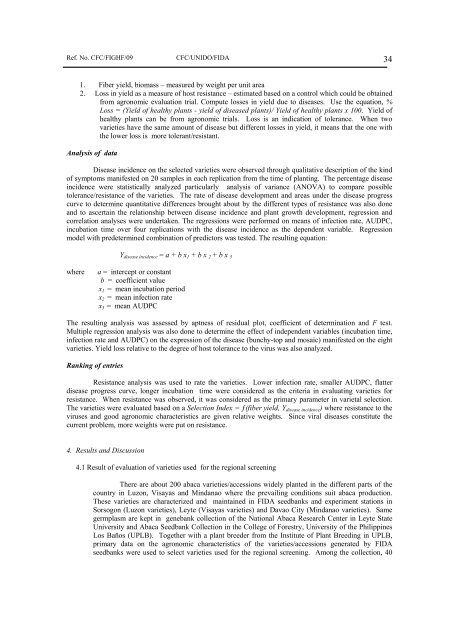ABACA Activities in the Philippines - Unido
ABACA Activities in the Philippines - Unido
ABACA Activities in the Philippines - Unido
You also want an ePaper? Increase the reach of your titles
YUMPU automatically turns print PDFs into web optimized ePapers that Google loves.
Ref. No. CFC/FIGHF/09 CFC/UNIDO/FIDA 34<br />
1. Fiber yield, biomass – measured by weight per unit area<br />
2. Loss <strong>in</strong> yield as a measure of host resistance – estimated based on a control which could be obta<strong>in</strong>ed<br />
from agronomic evaluation trial. Compute losses <strong>in</strong> yield due to diseases. Use <strong>the</strong> equation, %<br />
Loss = (Yield of healthy plants - yield of diseased plants)/ Yield of healthy plants x 100. Yield of<br />
healthy plants can be from agronomic trials. Loss is an <strong>in</strong>dication of tolerance. When two<br />
varieties have <strong>the</strong> same amount of disease but different losses <strong>in</strong> yield, it means that <strong>the</strong> one with<br />
<strong>the</strong> lower loss is more tolerant/resistant.<br />
Analysis of data<br />
Disease <strong>in</strong>cidence on <strong>the</strong> selected varieties were observed through qualitative description of <strong>the</strong> k<strong>in</strong>d<br />
of symptoms manifested on 20 samples <strong>in</strong> each replication from <strong>the</strong> time of plant<strong>in</strong>g. The percentage disease<br />
<strong>in</strong>cidence were statistically analyzed particularly analysis of variance (ANOVA) to compare possible<br />
tolerance/resistance of <strong>the</strong> varieties. The rate of disease development and areas under <strong>the</strong> disease progress<br />
curve to determ<strong>in</strong>e quantitative differences brought about by <strong>the</strong> different types of resistance was also done<br />
and to ascerta<strong>in</strong> <strong>the</strong> relationship between disease <strong>in</strong>cidence and plant growth development, regression and<br />
correlation analyses were undertaken. The regressions were performed on means of <strong>in</strong>fection rate, AUDPC,<br />
<strong>in</strong>cubation time over four replications with <strong>the</strong> disease <strong>in</strong>cidence as <strong>the</strong> dependent variable. Regression<br />
model with predeterm<strong>in</strong>ed comb<strong>in</strong>ation of predictors was tested. The result<strong>in</strong>g equation:<br />
Y disease <strong>in</strong>cidence = a + b x 1 + b x 2 + b x 3<br />
where<br />
a = <strong>in</strong>tercept or constant<br />
b = coefficient value<br />
x 1 = mean <strong>in</strong>cubation period<br />
x 2 = mean <strong>in</strong>fection rate<br />
x 3 = mean AUDPC<br />
The result<strong>in</strong>g analysis was assessed by aptness of residual plot, coefficient of determ<strong>in</strong>ation and F test.<br />
Multiple regression analysis was also done to determ<strong>in</strong>e <strong>the</strong> effect of <strong>in</strong>dependent variables (<strong>in</strong>cubation time,<br />
<strong>in</strong>fection rate and AUDPC) on <strong>the</strong> expression of <strong>the</strong> disease (bunchy-top and mosaic) manifested on <strong>the</strong> eight<br />
varieties. Yield loss relative to <strong>the</strong> degree of host tolerance to <strong>the</strong> virus was also analyzed.<br />
Rank<strong>in</strong>g of entries<br />
Resistance analysis was used to rate <strong>the</strong> varieties. Lower <strong>in</strong>fection rate, smaller AUDPC, flatter<br />
disease progress curve, longer <strong>in</strong>cubation time were considered as <strong>the</strong> criteria <strong>in</strong> evaluat<strong>in</strong>g varieties for<br />
resistance. When resistance was observed, it was considered as <strong>the</strong> primary parameter <strong>in</strong> varietal selection.<br />
The varieties were evaluated based on a Selection Index = ƒ(fiber yield, Y disease <strong>in</strong>cidence ) where resistance to <strong>the</strong><br />
viruses and good agronomic characteristics are given relative weights. S<strong>in</strong>ce viral diseases constitute <strong>the</strong><br />
current problem, more weights were put on resistance.<br />
4. Results and Discussion<br />
4.1 Result of evaluation of varieties used for <strong>the</strong> regional screen<strong>in</strong>g<br />
There are about 200 abaca varieties/accessions widely planted <strong>in</strong> <strong>the</strong> different parts of <strong>the</strong><br />
country <strong>in</strong> Luzon, Visayas and M<strong>in</strong>danao where <strong>the</strong> prevail<strong>in</strong>g conditions suit abaca production.<br />
These varieties are characterized and ma<strong>in</strong>ta<strong>in</strong>ed <strong>in</strong> FIDA seedbanks and experiment stations <strong>in</strong><br />
Sorsogon (Luzon varieties), Leyte (Visayas varieties) and Davao City (M<strong>in</strong>danao varieties). Same<br />
germplasm are kept <strong>in</strong> genebank collection of <strong>the</strong> National Abaca Research Center <strong>in</strong> Leyte State<br />
University and Abaca Seedbank Collection <strong>in</strong> <strong>the</strong> College of Forestry, University of <strong>the</strong> Philipp<strong>in</strong>es<br />
Los Baños (UPLB). Toge<strong>the</strong>r with a plant breeder from <strong>the</strong> Institute of Plant Breed<strong>in</strong>g <strong>in</strong> UPLB,<br />
primary data on <strong>the</strong> agronomic characteristics of <strong>the</strong> varieties/accessions generated by FIDA<br />
seedbanks were used to select varieties used for <strong>the</strong> regional screen<strong>in</strong>g. Among <strong>the</strong> collection, 40

















